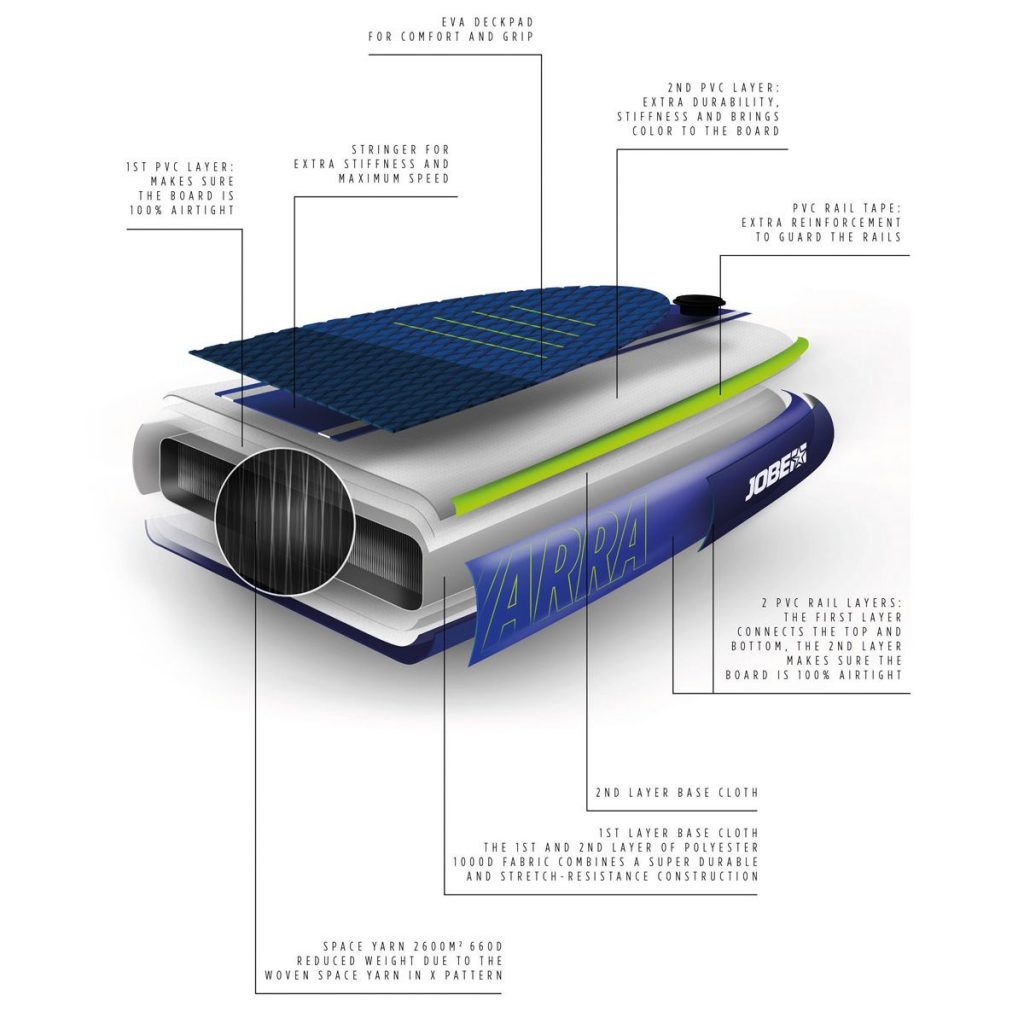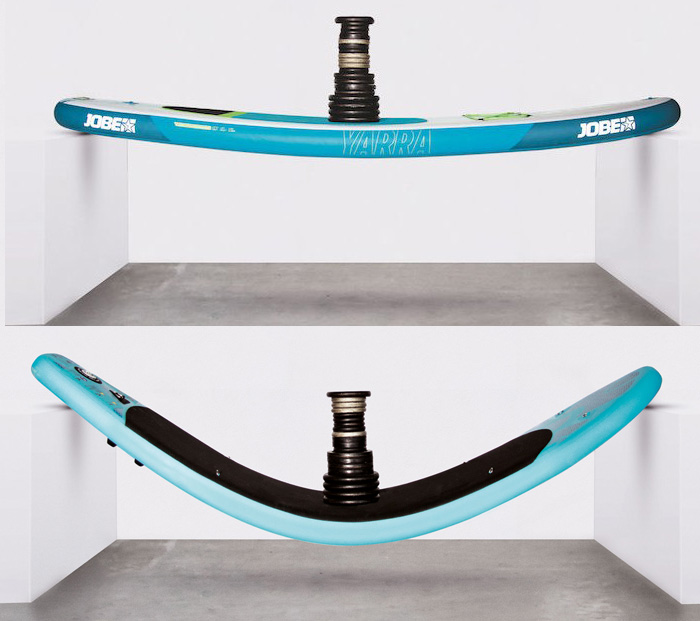Inflatable paddle boards, commonly known as iSUPs, vary in price based on several factors that can impact their performance, durability, and overall quality. Here are the key differences between a cheap and an expensive inflatable paddle board:
Material Quality:
- Cheap iSUPs often use lower-grade materials that may not be as durable or long-lasting. Expensive iSUPs typically use high-quality materials, such as military-grade PVC, which provide better durability and resistance to punctures and wear.
Construction Technology:
- Premium iSUPs utilise advanced construction techniques allowing them to make the board more rigid and much lighter than a cheap board. For example, the technology which holds the top and bottom of the board together is called Drop-Stitching
The term “drop-stitch” refers to a method of connecting the top and bottom layers of the paddle board using thousands of fine threads, creating a network of reinforced threads or “stitches” between the layers.
Here’s how drop-stitching works and why it’s important in iSUP construction:
- Structure and Design:
- In a drop-stitch construction, the top and bottom layers of the paddle board are initially connected by a series of threads or filaments. These threads run perpendicular to the surface of the board, connecting the top and bottom layers and creating an internal structure.
- Thread Density:
- The density and tightness of the threads are crucial. Manufacturers use thousands of threads within each square meter to achieve the desired level of rigidity. The more threads used, the higher the pressure the board can withstand, resulting in a stiffer and more stable paddle board. Premium boards will have a much higher density than a cheaper board and inflation pressures of 15-19psi. To make up for the less dense drop stitching, a cheaper board manufacturer will use more layers of PVC to try make the board more rigid. Adding significantly to its weight. If they don’t then the board is likely to fail after not a lot of use.
- X Stitching:
- Jobe use an advanced technology called X-Stitching, where instead of the drop stitches being vertical in the board, which would allow some lateral movement between the top and bottom layers, the stitches instead form an X pattern locking the top and bottom layers together both laterally and vertically
In summary, drop-stitching is a fundamental construction technique used in iSUPs, allowing them to achieve the necessary rigidity and structural integrity while remaining inflatable and portable for ease of transportation and storage
Heat Bonding
-
- The PVC layers on premium iSUPS will be heat bonded rather than glued together. Heat bonding is a manufacturing process used in inflatable paddle boards (iSUPs) to join the various layers of the board together. It involves using heat and pressure to fuse the layers of material, creating a strong and durable bond. This method is different from traditional gluing processes.
Here’s how heat bonding works and why it’s considered superior to glue in iSUP manufacturing:
- Process:
- During the heat bonding process, the layers of the iSUP (usually made of PVC or similar materials) are aligned and sandwiched together. Heat and pressure are then applied to melt the material, causing it to fuse and form a solid bond. This ensures a strong, airtight seal between the layers.
- Stronger Bond:
- Heat bonding typically creates a stronger and more durable bond compared to traditional glue-based bonding. The fused layers become integrated and cohesive, providing better resistance against separation, delamination, and leaks.
- Weight Saving
- Weight is saved in the construction of the board as no glue is added. This can save a lot of weight on the finished board, around 2kg of savings in glue!
- Uniformity:
- Heat bonding ensures a uniform bond across the entire surface, resulting in consistent strength and performance throughout the iSUP. In contrast, glue may sometimes result in uneven application or adhesive distribution.
- Airtight Sealing:
- Airtight sealing is crucial in iSUPs to maintain the required pressure for rigidity. Heat bonding creates a reliable, airtight seal that helps the board maintain its shape and buoyancy during use.
- Water Resistance:
- The heat bonding process often yields superior water resistance compared to glue. The melted material creates a seamless and watertight seal, minimizing the risk of water infiltration between the layers.
- Durability and Longevity:
- Heat-bonded seams are less likely to deteriorate over time, contributing to the overall durability and longevity of the iSUP. The bond is less susceptible to environmental factors, including exposure to water, sunlight, and temperature fluctuations.
- Environmental Considerations:
- Heat bonding may be considered more environmentally friendly compared to gluing methods that involve the use of potentially harmful chemicals.
In short heat bonded boards are 2kg lighter, stiffer, stronger, keep their shape, float easier through the water, more airtight and most importantly: super durable
Performance:
- Expensive iSUPs are designed for optimal performance, providing better stability, speed, tracking, and maneuverability. They are often shaped and constructed with precision to enhance their on-water capabilities. Cheaper iSUPs may lack the same level of performance and may not handle as well in varying water conditions.
Accessories:
- The easiest way to make a paddleboard cheap is to cut back on the quality of the accessories. Premium iSUPs typically come with high-quality accessories like fibreglass or carbon paddles, high-pressure dual or triple action pumps, durable backpacks, quality fins, repair kits, and a decent leash. Cheaper iSUPs may come with basic or lower-quality accessories, which could impact your overall paddling experience.
Brand and Reputation:
- Established and reputable brands often produce more expensive iSUPs due to their reputation for quality, customer service, and reliability. Cheaper iSUPs may be from lesser-known or generic brands, which may not have the same level of quality assurance and support.
Warranty and Customer Service:
- Premium iSUPs typically come with better warranty options and customer service. Jobe now warranties all of its iSUPs for 5 years! The manufacturer may offer extended warranties, repair services, or replacements for any defects. Cheaper iSUPs might have limited or no warranties, making it challenging to address any potential issues.
Weight:
- As a general rule of thumb, a more premium paddleboard will be lighter and no corners will be cut to get it to that weight. It will be lighter because of the technology used to get it to that weight as we have discussed above. It will have denser drop stitching, less layers of pvc, be heat bonded rather than glued
It’s important to consider your specific needs, budget, and intended use when choosing between a cheap and an expensive inflatable paddle board. We hope we have given you some quality information on which to base your decision on. Investing in a higher-quality iSUP can provide a more enjoyable and long-lasting paddling experience.
Checkout our range of Inflatable Paddleboards here





